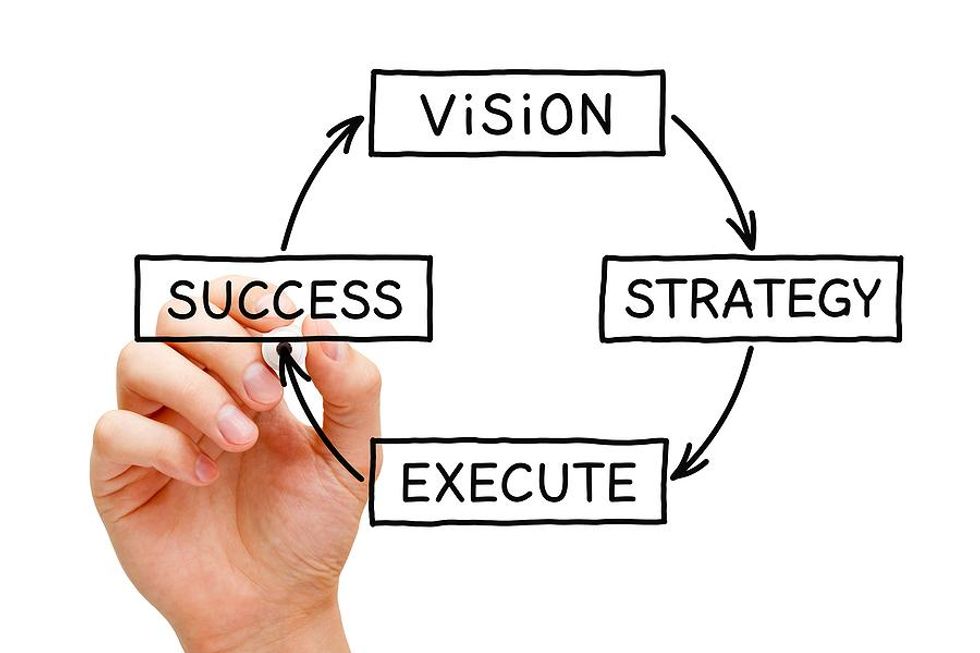
Roadmaps are beautiful. Not just because they are aesthetically pleasing but because of what they represent. Roadmaps clearly show what you want to achieve and how you will get there. You can create excitement for a big idea and package it in a way that others can understand. But a roadmap is still just a visualization. You need to have a vision and strategy behind the plan.
Vision, Strategy, And Roadmapping

Bigstock
You need to understand the purpose of each to build something lasting deeply. All three are clearly defined on successful product and project teams.
A Simple Analogy — Making a Case for All Three
Think of a skyscraper.
1. Vision is the initial thought about what kind of place it will be and why it will matter.
- Vision is your view of the future.
2. Strategy is the blueprint for the foundation and framing.
- Explains the approach that you’ll take to realize that future state.
3. The roadmap builds upon the blueprint with a detailed plan for erecting a fully functioning structure.
- The roadmap is the more tactical plan for what you will do to get there (and when you arrive), informed by the vision and strategy.
Build Your Strategic Roadmap!

Bigstock
No matter where you work or how your organization approaches strategic planning, it is essential to have a firm grasp on each term and what it is not. Here is a helpful way to think about vision, strategy, and roadmapping.
Vision
Vision is about the future and, hopefully, a better world. It is the essence of what you hope to achieve and forms the beginning of your strategy. For example, our vision at the National Football League was to deliver a great fan experience.
Vision is not a statement that you define once and forget about it. Vision is a living and breathing thing. And it should not be overly complex or challenging to parse—everyone in the company needs to know and deeply understand it.
Strategy
Strategy defines the direction you will take to achieve your vision. The plan aligns the entire organization around what you want to accomplish and guides how to turn the idea into reality. It lays out your goals and the key strategic initiatives to be successful.
Strategy is not the tactical work you will do. But it is not in the background either; it informs every decision about which activities to invest in. Strategy is cross functional for significant efforts. Every team needs to understand how their work is related to their part in achieving critical objectives.
Strategic Roadmaps
A strategy roadmap is a tool that helps you visualize your strategic plan. Strategic roadmaps capture activities you will complete within a given time frame and communicate upcoming work in one view. You can use a roadmap to drive conversations. It can guide prioritizing work, allocating resources, and tracking dependencies.
A roadmap is not static. You can adjust as plans change, show progress as you complete work, and create tailored views for different audiences. A roadmap should be exciting. It is a visual guide that defines the work required for the team to be its best.
Keep a Clear Vision
A vision statement provides much value, even just a few sentences. Not only does it outline the company’s desired outcome, but it can communicate intentions and hopes for the future. The best part is that a vision statement changes with your organization. When a vision is reached or updated, it’s time to create a new vision statement. This encourages everyone toward more meaningful goals and opens your company to more possibilities.
5 Ways To Vastly Improve Strategic Visioning In Leadership

Bigstock
Step 1: Clarify Your Purpose
Why does your organization/unit/function exist? What need must be met? What opportunities can be addressed?
Be clear about the purpose and continually use this purpose to center and re-center your efforts while guiding your constituents in seeing the long-term vision you are creating.
- Choose a focus: In most cases, your vision and strategy should target those areas that define the purpose of your organization and make it valuable. What is most important? What will distinguish you from the competition? Who are the customers, and how do you bring them value?
- Stay true to your core values: What is the heart and soul of your company, organization, or department? While change is the constant of any forward-looking strategy, many companies fail because they have strayed too far from what has made them successful.
Step 2: Become the King of Information
Stay constantly informed and up to date about your industry and competitors, as well as what’s happening right within your company.
- Become a voracious consumer of knowledge: Read broadly in your technical or business literature and the more general press. Be aware of what is happening in your industry and the more significant business, social, and political environments.
- Seek information from everyone: Often, you will get the most valuable information from those who are interacting most closely with your direct customers.
Step 3: Embrace an Innovative Mindset
Innovative organizations are usually more profitable, retain higher caliber employees, and lead by example.
- Playing devil’s advocate: Ask probing questions, challenge the status quo, encourage others to be creative and stretch themselves, try new things, and take risks.
- Thinking differently: There are different types of creative thinking. Creativity only sometimes means producing a new concept or idea. On the contrary, most productive creativity occurs when someone looks at an old solution slightly differently to find a better way.
Step 4: Translate Your Ideas Into Specific Actions
The best ideas are worthless unless they are acted upon effectively.
- Make it simple: Many strategic initiatives fail due to the complexity of the vision. What are the core things that you want to accomplish? How can you make them clear and actionable?
Step 5: Communicate Effectively
The best vision and strategy can only succeed if communicated well.
- Determine your audience: Who needs to know?
- One message does not fit all: Create different messages for different audiences.
- Make it real: Communicating your strategy via a story about people or a situation they understand can be much more understandable and memorable.
- Communicate — over and over: Keep your vision and strategy alive through continuous updates to everyone involved.
- How I Used Project Management To Excel In Life ›
- The Overwhelming Need For Storytelling In Business ›
- How To Achieve More With Less Through Business Partnerships ›
- Top 5 Questions To Answer To Get Your Data Strategy Just Right ›
- From Bucket List To Project Life Roadmap In 8 Simple Steps ›
- The Best Tips For Team Goal Setting & Business Planning - Work It Daily ›

 Bigstock
Bigstock Bigstock
Bigstock Bigstock
Bigstock


